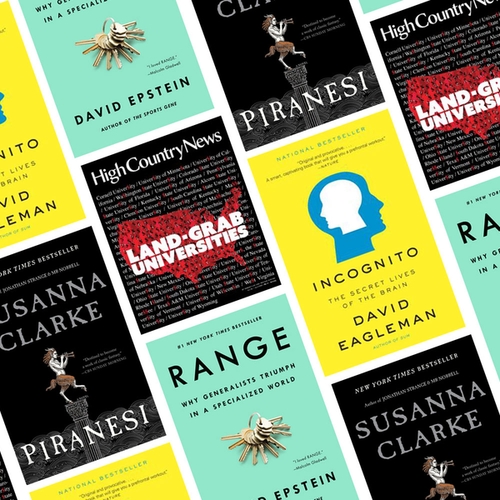IAS Staff and Fellows share books and articles we think you might like, too.
“Land-Grab Universities: Expropriated Indigenous Land is the Foundation of the Land-Grant University System”
by Robert Lee and Tristan Ahtone
High Country News
March 30, 2020
In the last year, one article and its thorough documentation has jump-started conversations across the country about what it really means to be a land grant university, the origin of our “public” endowments, and our obligations to the Indigenous people who provided them through coercion and dispossession. Robert Lee and Tristan Athone’s article in the High Country News on “Land-Grab Universities” represents a two-year project to assemble and map the data documenting the Morrill Act’s “massive wealth transfer masquerading as a donation” and the coercion, fraud, and theft involved in the U.S. acquisition of 10.7 million acres of Indigenous land that were transferred to land grant institutions to use or sell in perpetuity. Twelve states still hold unsold lands and mineral rights. Minnesota’s story is at the heart of the history: about 830,000 acres ceded by the Dakota in the treaty of 1851 (“one out of every 13 acres redistributed under the Morrill Act”) ultimately funded 35 land grant universities, not least our own. The land was valued at $5-10 per acre, but the “Dakota were paid less than 2.4 cents per acre.” What University of Minnesota received and then leased or sold amounts to more than $10.5m today. This history adds a whole new meaning to the language of President Gabel’s land acknowledgement that “words are not enough.” I appreciate anew the work that the Decolonization and Community-Engaged Scholarship Roundtable has been doing to move land acknowledgement beyond lip service.
—Jennifer Gunn, Director
Editor’s note: The IAS is pleased to be offering a short-term, interdisciplinary fellowship this May–June on the Mission of the Land Grant/Land Grab University. The fellowship will be an opportunity for participants to further research and creative work across all disciplines that addresses some aspect of the duality of the land grant university, its research and educational missions, and attempts to move toward repair. Learn more and apply—applications are due March 29 at noon.
Incognito: The Secret Lives of the Brain
David Eagleman
Vintage, 2011
Incognito beautifully discusses many of the mysteries of what the brain gets up to when you’re otherwise occupied. The book has reminded me of the magic and mystery of the ways brains work, and how we both know so very much about them and us, and so very little. It has been great comfort in a challenging year, though I will admit to a bit of laying awake at night, thinking about thinking.
—Joanne Richardson, Digital Information Strategist and Open Rivers Production Manager
Range: Why Generalists Triumph in a Specialized World
David Epstein
Riverhead Books, 2019
In trying to describe the work of the IAS, one member of our team described themselves as an “avid generalist,” which we realized also suited most of us. We are interested in lots of things, and how we might work together to create new and more interesting connections. This is also a good description of the IAS.
When I heard about David Epstein’s book Range: How Generalists Triumph in a Specialized World, I was immediately intrigued for similar reasons. Epstein examines a variety of fields—education (including research, as well as teaching/learning), sports, business, and parenting—to look at the value of generalists in creating new knowledge. It was a great read focused on the value of how things that are seemingly unrelated can sometimes answer the biggest questions, and the value of outsider perspective/knowledge. This book definitely encouraged me even more on the importance of the work of the IAS!
—Brianna Menning, Programs and Communications Manager
Piranesi
Susanna Clarke
Bloomsbury, 2020
Susanna Clarke has created an extraordinary world for her readers to lose themselves in. Piranesi is presented as a series of journal entries by the protagonist, who is called Piranesi, “Which is strange because as far as I can remember it is not my name.” But who is Piranesi? What does he actually remember? And what is the mysterious House that constitutes his universe, which he has dedicated his life to exploring and cataloging?
Clarke takes the reader on a journey of discovery, one that mirrors Piranesi’s own research into the House and the “Great and Secret Knowledge” that it might contain. The descriptions of the Halls, Vestibules, Staircases, and Statues—made all the more evocative by Piranesi’s habits of capitalization—lull the reader into a sense of solid certainty. But is it real? The pleasure of this book is in the slow unfolding of layers of reality, perception, and memory.
This book is a delight to read, with its delicious prose and intriguing imagery, as well as the underlying kindness and decency that the title character brings. If C. S. Lewis’s The Magician’s Nephew is an old friend, you will appreciate a few inside references to that as well. For me, this was a great pandemic read: an engrossing tale of loneliness and the rituals that we create to give meaning to our lives, one that ultimately turns on how people can care about, and for one another. It left me feeling like I had traveled to a strange and wonderful place. “The Beauty of the House is immeasurable; its Kindness infinite.”
—Susannah Smith, Managing Director




